Osteoporosis Drug Comparison Tool
Actonel (Risedronate)
Oral tablet – weekly or monthly
- Key Advantage: Strong fracture-risk reduction; flexible dosing
- Typical Caution: Renal impairment; esophageal irritation
Alendronate (Fosamax)
Oral tablet – weekly
- Key Advantage: Long-track record; generic options lower cost
- Typical Caution: Same GI side effects; adherence challenges
Ibandronate (Boniva)
Oral monthly or IV every 3 months
- Key Advantage: Convenient monthly pill; IV for poor oral tolerance
- Typical Caution: Potential acute-phase reaction after IV
Zoledronic Acid (Reclast)
IV infusion – once yearly
- Key Advantage: Excellent adherence; works in renal impairment
- Typical Caution: Requires clinic visit; potential flu-like symptoms
Denosumab (Prolia)
Subcutaneous injection – every 6 months
- Key Advantage: Works differently (RANKL inhibition); reversible
- Typical Caution: Risk of infections; requires regular injections
Teriparatide (Forteo)
Daily injection – up to 2 years
- Key Advantage: Builds new bone; effective for severe cases
- Typical Caution: Expensive; limited to 2-year course
How to Choose Your Osteoporosis Medication
Consider these factors when selecting a treatment:
- Adherence: How often do you take medication? Monthly or yearly options may suit your lifestyle better.
- Renal Function: Some drugs aren't suitable if you have kidney problems.
- Side Effects: GI issues, flu-like symptoms, or injection site reactions vary by drug.
- Budget: Generic options like alendronate can save money compared to newer injectables.
- Doctor’s Recommendation: Your healthcare provider considers your medical history and current conditions.
Quick Takeaways
- Actonel is a potent bisphosphonate but may not be ideal for patients with kidney issues.
- Alendronate and ibandronate are oral alternatives with similar efficacy and easier dosing schedules.
- Zoledronic acid offers once‑yearly IV dosing, great for adherence but requires clinic visits.
- Denosumab works differently (RANKL inhibition) and is reversible within months of stopping.
- Injectable anabolic agents like teriparatide rebuild bone but are expensive and limited to two‑year courses.
What is Actonel (Risedronate)?
When treating osteoporosis, Actonel (risedronate) is a well‑known bisphosphonate that many patients recognize from pharmacy bottles. Actonel is a bisphosphonate medication whose active ingredient is risedronate sodium, used to increase bone mineral density and reduce the risk of vertebral and non‑vertebral fractures. It received FDA approval in 2001 and is available in 5mg and 35mg tablets for weekly or monthly dosing.
Risedronate belongs to the same drug class as alendronate and ibandronate, sharing a common mechanism of binding to hydroxyapatite in bone and inhibiting osteoclast‑mediated resorption.
How Does Actonel Work?
Risedronate’s chemical structure lets it lodge into bone surface during remodeling. Once attached, it interferes with the mevalonate pathway inside osteoclasts, leading to apoptosis (cell death). Fewer active osteoclasts mean slower bone turnover and a net gain in bone mass.
The effect on bone turnover markers is measurable within weeks, while meaningful increases in bone mineral density (BMD) show up on DEXA scans after six months of consistent use.
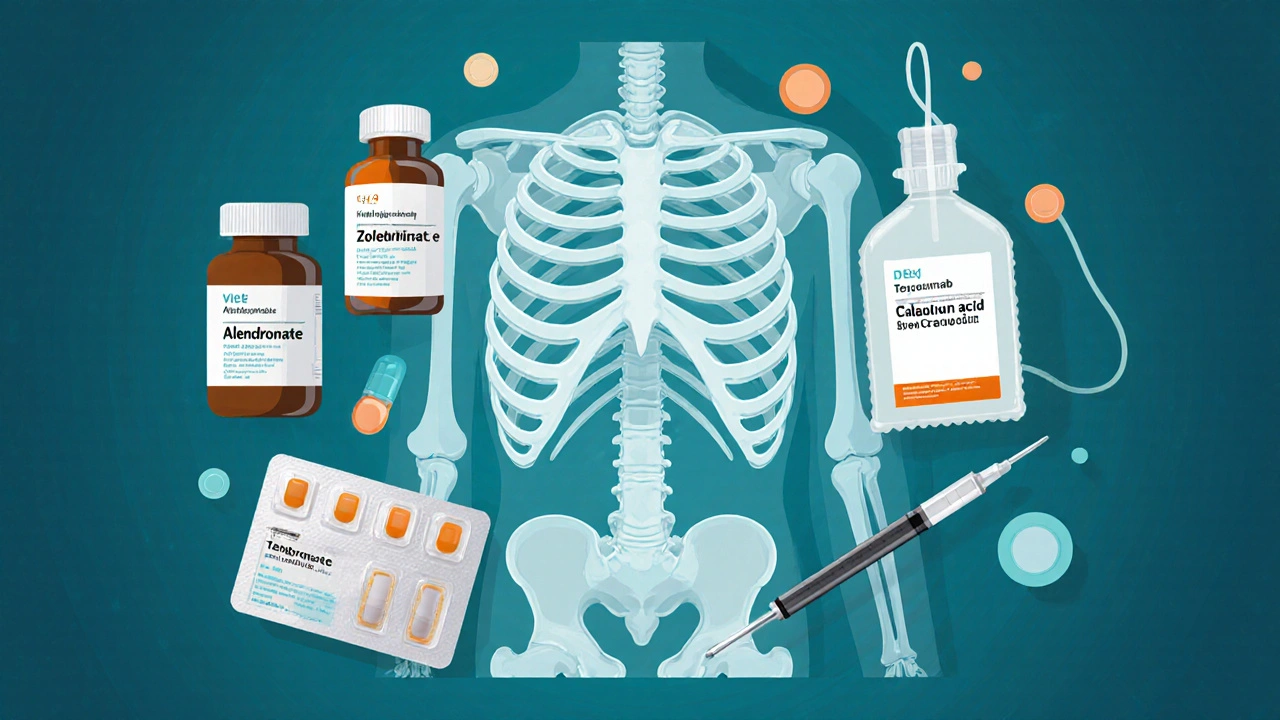
Who Uses Actonel?
Actonel is indicated for post‑menopausal women, men with primary osteoporosis, and patients on long‑term glucocorticoid therapy. It is also approved for prevention of osteoporosis in post‑menopausal women at increased risk.
Key patient groups include:
- Women over 50 with a history of low‑impact fractures.
- Men over 60 with a T‑score ≤‑2.5.
- Patients on prednisone ≥5mg/day for three months or longer.
Comparing the Main Alternatives
Below is a side‑by‑side snapshot of the most frequently prescribed alternatives. The table highlights dosage form, frequency, major pros, and common cautions.
| Drug (Active Ingredient) | Form / Frequency | Key Advantage | Typical Caution |
|---|---|---|---|
| Actonel | Oral tablet - weekly or monthly | Strong fracture‑risk reduction; flexible dosing | Renal impairment; esophageal irritation |
| Alendronate (Fosamax) | Oral tablet - weekly | Long‑track record; generic options lower cost | Same GI side effects; adherence challenges |
| Ibandronate (Boniva) | Oral monthly or IV every 3 months | Convenient monthly pill; IV for poor oral tolerance | Potential acute-phase reaction after IV |
| Zoledronic acid (Reclast) | IV infusion - once yearly | Excellent adherence; works in renal <0.5ml/min/1.73m² | Flu‑like symptoms; requires clinic visit |
| Denosumab (Prolia) | Subcutaneous injection - every 6 months | Effective in patients with severe renal disease | Rebound bone loss if missed; risk of hypocalcemia |
| Teriparatide (Forteo) | Daily subcutaneous injection | Stimulates new bone formation, good for very low BMD | High cost; limited to 2‑year lifetime use |
| Calcium carbonate | Oral tablet - multiple daily doses | Essential building block; inexpensive | May cause constipation; needs vitaminD for absorption |
| Vitamin D3 (cholecalciferol) | Oral capsule - daily | Enhances calcium absorption, reduces fall risk | Over‑supplementation can lead to hypercalcemia |
Deep Dive into Each Alternative
Alendronate (Fosamax)
Alendronate is an oral bisphosphonate taken once a week. Clinical trials show a 44% reduction in vertebral fractures after three years of therapy. It’s widely available as a generic, making it budget‑friendly for many seniors.
Patients must stay upright for at least 30minutes after swallowing to avoid esophageal irritation. Those with swallowing disorders often switch to IV ibandronate or zoledronic acid.
Ibandronate (Boniva)
Ibandronate comes as a monthly oral tablet or a three‑monthly IV injection. The monthly pill is taken on an empty stomach, similar to other bisphosphonates, but the three‑monthly IV version bypasses GI concerns entirely.
Side‑effects include transient fever and muscle aches after the IV dose-usually resolve within 24hours. It's a solid middle ground for patients who struggle with weekly dosing.
Zoledronic Acid (Reclast)
Zoledronic acid is a potent bisphosphonate administered as a 5mg IV infusion once per year. Its once‑yearly schedule dramatically improves adherence, especially in nursing‑home settings.
The infusion can cause an acute‑phase reaction (flu‑like symptoms) that typically fades after a few days. Kidney function must be checked beforehand; it’s contraindicated if creatinine clearance <30ml/min.
Denosumab (Prolia)
Denosumab is a monoclonal antibody that blocks RANKL, preventing osteoclast formation. It’s delivered as a 60mg subcutaneous injection every six months.
Denosumab shines in patients with severe renal impairment because it isn’t cleared by the kidneys. However, missing an injection can trigger rapid bone loss, so adherence to the six‑month schedule is critical.
Teriparatide (Forteo)
Teriparatide is a recombinant form of parathyroid hormone given as a daily 20µg injection. It’s the only approved anabolic (bone‑building) therapy for osteoporosis.
It’s reserved for patients with very low BMD or those who have failed other therapies. Insurance coverage varies, and therapy is capped at two years due to safety concerns about osteosarcoma in animal studies.
Calcium Carbonate
Calcium carbonate supplies elemental calcium-about 40% of daily recommended intake per 500mg tablet. It works best when taken with meals because stomach acid improves absorption.
Excessive calcium can lead to kidney stones; therefore, pairing it with vitaminD (see below) helps the body use the mineral more efficiently.
Vitamin D3 (Cholecalciferol)
Vitamin D3 is the most bioavailable form of vitaminD for humans. A typical dose ranges from 800IU to 2000IU daily, depending on baseline serum 25‑OH‑D levels.
Adequate vitaminD is essential for calcium absorption and has been linked to reduced fall risk, an indirect way to lower fracture incidence.
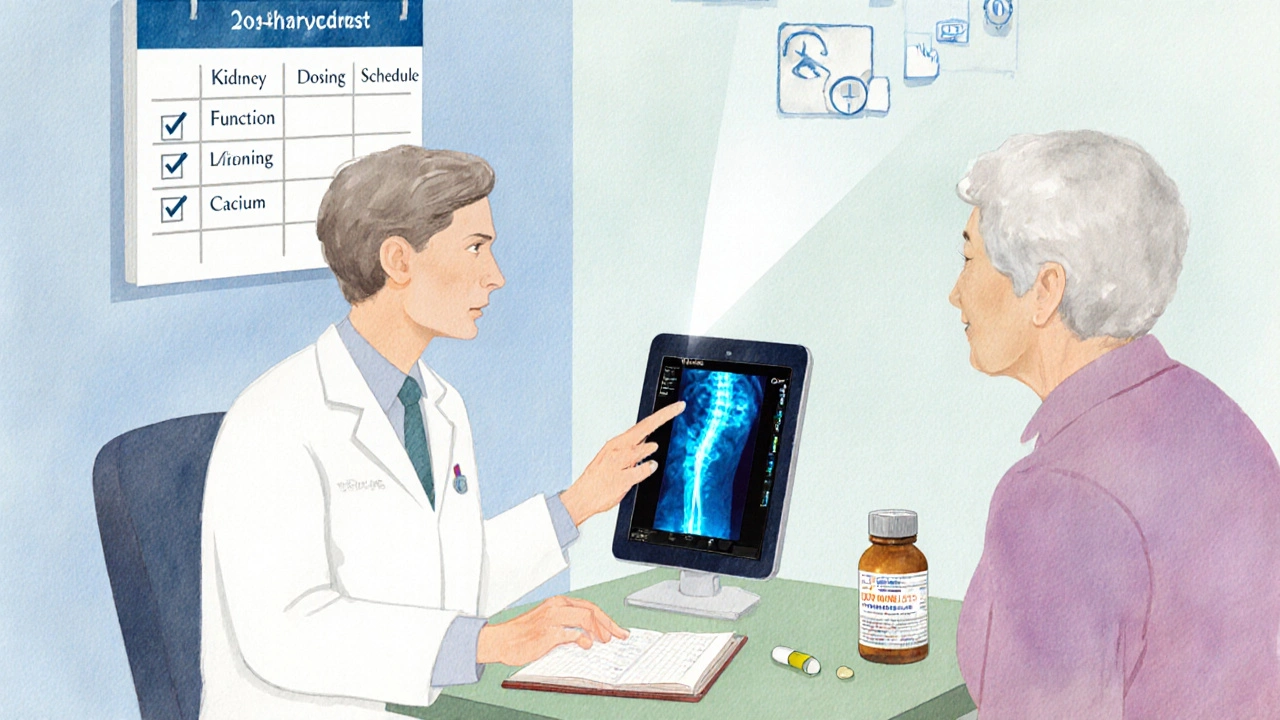
Choosing the Right Medication - Decision Criteria
- Kidney Function: If creatinine clearance <30ml/min, avoid oral bisphosphonates and consider denosumab or calcium/vitD alone.
- Adherence Ability: Patients who forget pills benefit from yearly zoledronic acid or six‑monthly denosumab.
- Gastro‑intestinal Tolerance: Swallowing issues or reflux redirect therapy toward IV bisphosphonates or subcutaneous agents.
- Cost & Insurance Coverage: Generic alendronate is cheapest; newer agents may need prior‑auth.
- Bone Turnover Profile: High turnover cases (elevated CTX) may respond better to anabolic teriparatide before bisphosphonate consolidation.
Discuss these factors with a healthcare professional; a shared decision‑making approach leads to better long‑term outcomes.
Safety Tips & Common Side Effects
- Esophageal irritation: Take any oral bisphosphonate with a full glass of water, stay upright for at least 30minutes.
- Acute‑phase reaction: For IV drugs, pre‑medicate with acetaminophen or ibuprofen if flu‑like symptoms appear.
- Hypocalcemia: Check serum calcium before starting denosumab; supplement with calcium/vitaminD if needed.
- Osteonecrosis of the jaw (ONJ): Avoid invasive dental work while on high‑potency bisphosphonates; maintain good oral hygiene.
- Renal monitoring: Labs every 6-12months for patients on zoledronic acid or high‑dose oral bisphosphonates.
Practical Checklist for Patients Starting Therapy
- Confirm diagnosis with DEXA scan and review T‑score.
- Get baseline labs: serum calcium, vitaminD, creatinine clearance.
- Choose a dosing schedule you can stick to (weekly, monthly, yearly).
- Set reminders on your phone or use a pill‑box.
- Schedule a follow‑up DEXA after 12-24months to gauge response.
Frequently Asked Questions
Can I switch from Actonel to another bisphosphonate without a washout period?
Generally, a short washout of 1-2weeks is recommended to reduce the risk of overlapping side effects, especially gastrointestinal irritation. Your doctor may tailor the interval based on your kidney function and fracture risk.
Is denosumab safer for patients with chronic kidney disease?
Yes. Because denosumab is cleared via the reticulo‑endothelial system rather than the kidneys, it can be used in stages 3-5 CKD. However, monitoring calcium levels is still essential.
What’s the biggest advantage of the yearly zoledronic acid infusion?
Adherence. One infusion per year removes the daily or weekly pill burden, which is a common reason for treatment failure in older adults.
Do I still need calcium and vitaminD if I’m on a bisphosphonate?
Absolutely. Bisphosphonates help preserve bone, but they can’t build new bone without adequate calcium and vitaminD. Most guidelines recommend at least 1,200mg calcium and 800-1,000IU vitaminD daily.
How long can I stay on Actonel?
Treatment is usually limited to 3-5years. After that, a “drug holiday” may be advised to reduce rare side effects like atypical femoral fractures. Your doctor will assess BMD trends before deciding.

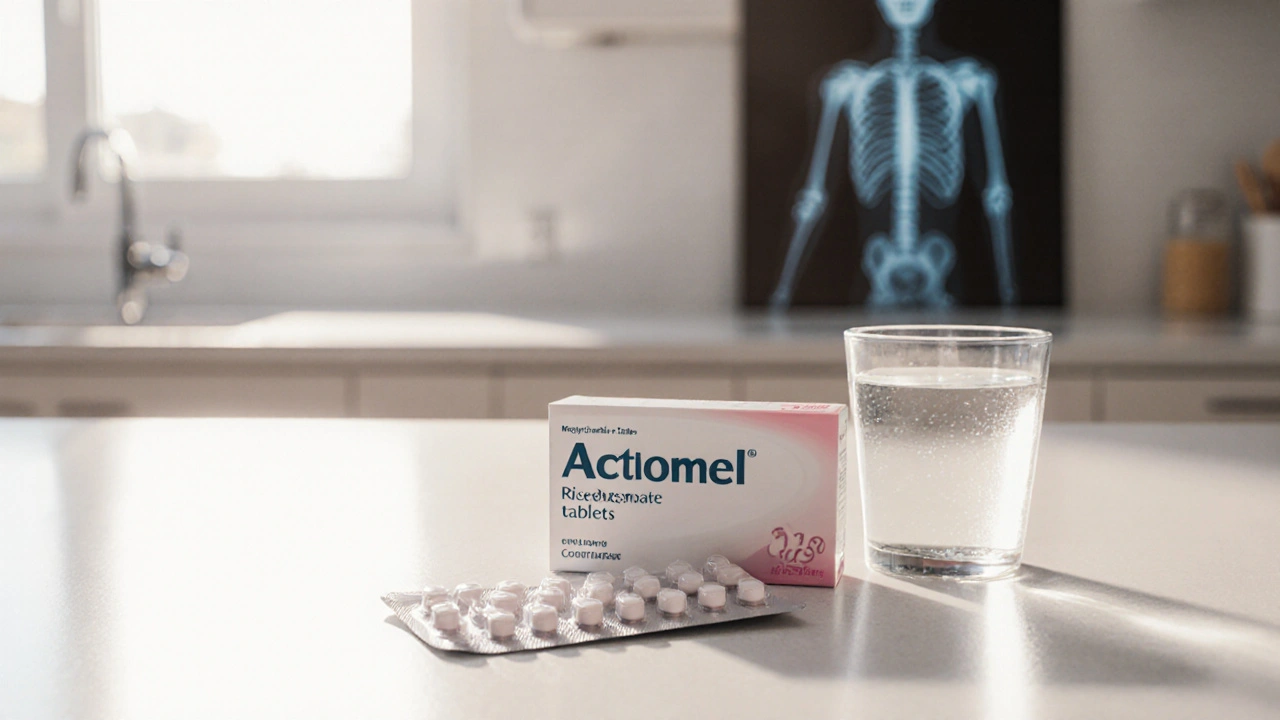
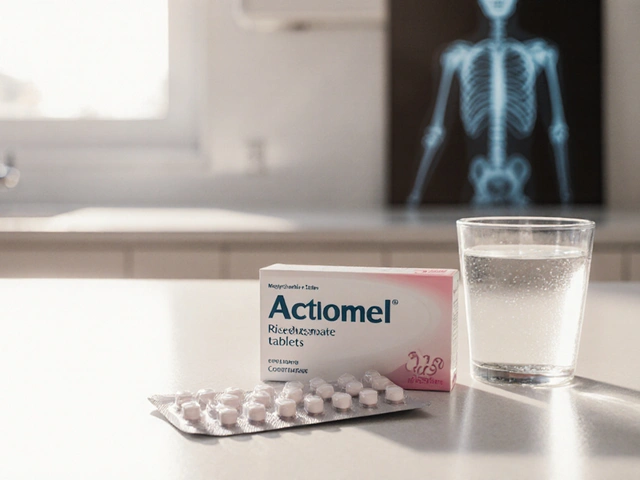
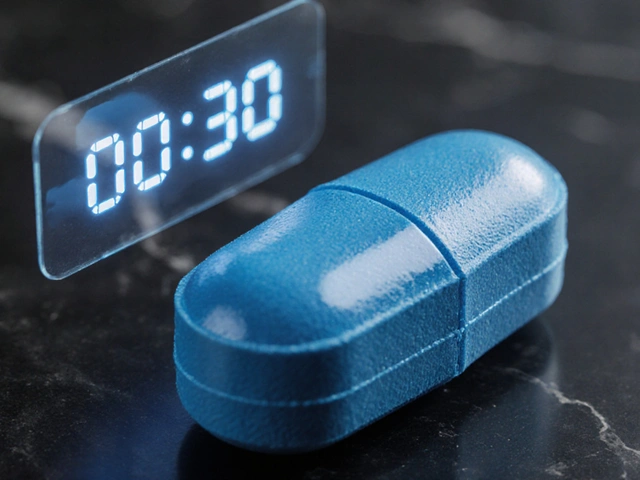


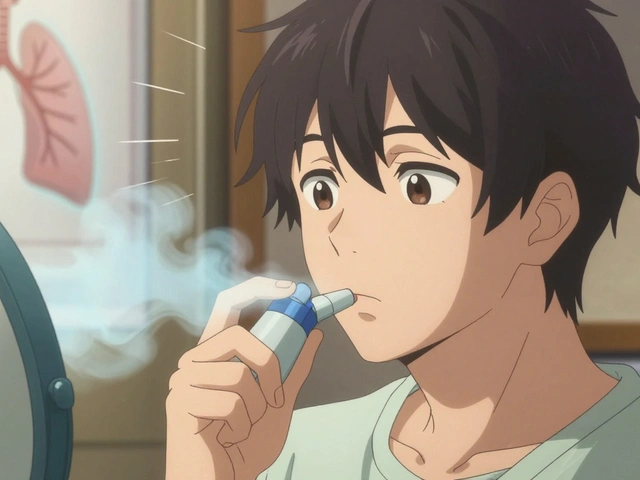

Comments
Actonel’s esophageal irritation risk makes it a pain for anyone who can’t master the upright swallow.
Oh great, another bisphosphonate that pharma pushes like it’s the only hope for brittle bones. They love to hide the renal red‑flag behind glossy pamphlets, hoping you don’t read the fine print. The weekly tablet sounds convenient until you realize you have to stay upright for half an hour-talk about a ritual. Plus, the cost isn’t exactly charity‑ware, especially when insurance plays hardball.
Mate, I’ve read the UK formularies and they’re all over the place-some say Actonel is fine, others flag the kidney issue like a red flag on a warship. The risk isn’t a myth, it’s real, but they also love to oversell the benefits and drown you in jargon. If you can’t tolerate the pill, maybe look at the IV options that the NHS offers, they’re not as hyped but get the job done.
Honestly, the drama around Actonel is like a soap opera-one day it’s the hero, the next it’s the villain. My aunt switched to it after a fracture, but the stomach burn turned her into a mini‑actress, complaining about every meal. The monthly dosing sounds sweet until you remember the extra water requirement. And the price? It’s enough to make anyone’s wallet cry.
That’s a classic case of side‑effects outweighing convenience. In practice, many patients find alendronate or ibandronate just as effective with a lower price tag, especially when you can grab a generic. If you’ve got renal concerns, consider zoledronic acid or denosumab-they sidestep the GI track entirely. Always check with your pharmacist about bulk‑purchase programs; they can shave off a decent chunk.
Actonel is a solid bisphosphonate, no doubt-its fracture‑risk reduction stats are impressive! However, the esophageal irritation and renal cautions are not trivial; they demand strict adherence to dosing instructions. If you’re looking for a flexible regimen, the monthly tablet can be convenient, but only if you can maintain the upright posture for 30 minutes. Consider discussing with your doc whether an IV or a RANKL inhibitor might align better with your lifestyle! 😊